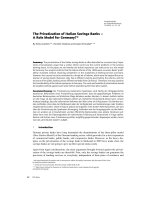- Trang chủ >>
- Khoa Học Tự Nhiên >>
- Vật lý
the phonology of italian jul 2009
Bạn đang xem bản rút gọn của tài liệu. Xem và tải ngay bản đầy đủ của tài liệu tại đây (1.17 MB, 299 trang )
The Phonology of Italian
The Phonology of the World’s Languages
General Editor: Jacques Durand
Published
The Phonology of Danish
Hans Basbøll
The Phonology of Dutch
Geert Booij
The Phonology of Standard Chinese, second edition
San Duanmu
The Phonology of Polish
Edmund Gussmann
The Phonology of English
Michael Hammond
The Phonology of Italian
Martin Krämer
The Phonology of Norwegian
Gjert Kristoffersen
The Phonology of Portuguese
Maria Helena Mateus and Ernesto d’Andrade
The Phonology and Morphology of Kimatuumbi
David Odden
The Lexical Phonology of Slovak
Jerzy Rubach
The Phonology of Hungarian
Péter Siptár and Miklós Törkenczy
The Phonology of Mongolian
Jan-Olof Svantesson, Anna Tsendina, Anastasia Karlsson, and Vivan Franzén
The Phonology of Armenian
Bert Vaux
The Phonology and Morphology of Arabic
Janet Watson
The Phonology of Catalan
Max Wheeler
The Phonology of German
Richard Wiese
In preparation
The Phonology of Icelandic and Faroese
Kristján Árnason
The Phonology of Tamil
Prathima Christdas
The Phonology of Japanese
Laurence Labrune
The Phonology of Spanish
Iggy Roca
The Phonology of Swedish
Tomas Riad
The Phonology of Washo
Alan C. L. Yu
THE
PHONOLOGY
OF
ITALIAN
Martin Krämer
1
3
Great Clarendon Street, Oxford ox2 6dp
Oxford University Press is a department of the University of Oxford.
It furthers the University’s objective of excellence in research, scholarship,
and education by publishing worldwide in
Oxford New York
Auckland Cape Town Dar es Salaam Hong Kong Karachi
Kuala Lumpur Madrid Melbourne Mexico City Nairobi
New Delhi Shanghai Taipei Toronto
With offices in
Argentina Austria Brazil Chile Czech Republic France Greece
Guatemala Hungary Italy Japan Poland Portugal Singapore
South Korea Switzerland Thailand Turkey Ukraine Vietnam
Oxford is a registered trade mark of Oxford University Press
in the UK and in certain other countries
Published in the United States
by Oxford University Press Inc., New York
© Martin Krämer 2009
The moral rights of the author have been asserted
Database right Oxford University Press (maker)
First published 2009
All rights reserved. No part of this publication may be reproduced,
stored in a retrieval system, or transmitted, in any form or by any means,
without the prior permission in writing of Oxford University Press,
or as expressly permitted by law, or under terms agreed with the appropriate
reprographics rights organization. Enquiries concerning reproduction
outside the scope of the above should be sent to the Rights Department,
Oxford University Press, at the address above
You must not circulate this book in any other binding or cover
and you must impose the same condition on any acquirer
British Library Cataloguing in Publication Data
Data available
Library of Congress Cataloging in Publication Data
Data available
Typeset by SPI Publisher Services, Pondicherry, India
Printed in Great Britain
on acid-free paper by
MPG Biddles Ltd., King’s Lynn, Norfolk
ISBN 978–0–19–929079–6
13579108642
CONTENTS
Acknowledgements viii
Notation Conventions ix
The International Phonetic Alphabet x
Abbreviations xi
1 INTRODUCTION 1
1.1 Approaching Italian 1
1.2 A rationale 3
1.3 An overview of this book 5
1.4 Orthography 8
2 THEORETICAL BACKGROUND 11
2.1 Optimality Theory 11
2.2 The parallel structures model of segmental representations 17
3 A VERY BRIEF HISTORY OF ITALIAN PHONOLOGY 22
3.1 Latin as a starting point 23
3.2 Major developments on the way from Latin to Italian 25
3.2.1 Changes in the consonantal system 26
3.2.2 Changes in the vowel system 30
3.2.3 Changes in prosodic organization 33
3.3 Explaining historical change 35
3.3.1 Neogrammarian sound change 35
3.3.2 Contrast innovation and fading-out of phonologicalprocesses 36
3.3.3 Classical lexical diffusion 39
3.3.4 Rule inversion 42
3.3.5 Summary 42
4 SEGMENTAL PHONOLOGY 44
4.1 The sound inventory 45
4.1.1 Consonants 45
4.1.2 Vowels 50
4.2 Segmental alternations 56
4.2.1 Palatalization 56
4.2.1.1 Alveolar affrication and velar palatalization 57
4.2.1.2 Place features 68
4.2.1.3 Constraint-based analysis of palatalization 73
4.2.2 The status of glides: vowel-glide alternations 84
4.2.2.1 Separating high vowels and glides 85
4.2.2.2 Analysis 91
vi contents
4.2.3 Vowel neutralization 99
4.2.3.1 Overview 100
4.2.3.2 Representations and derivations of metaphony 104
4.2.3.3 Unstressed vowel reduction and metaphony in OT 111
4.2.3.4 Summary 123
4.3 A feature set for the Italian segment inventory 124
5 SYLLABLE STRUCTURE 127
5.1 Italian onset phonotactics 128
5.2 The rhyme 134
5.2.1 The size of the rhyme 135
5.2.2 The coda condition 137
5.3 Across syllable boundaries 140
5.4 An OT analysis 142
6 WORD STRESS 156
6.1 Overview 156
6.2 Default stress 160
6.2.1 Identifying the problem 160
6.2.2 Nonce-word test method 167
6.2.3 Results 169
6.2.4 Analysis of nonce-word stress patterns 177
6.2.4.1 All light syllables 179
6.2.4.2 Quantity 183
6.2.5 Comments and further refinement 185
6.3 Lexical stress 187
6.3.1 Conflicting stress marks 187
6.3.2 OT analysis of lexical stress 190
6.4 Secondary stress 194
6.5 The domain of stress 197
7 PROSODIC PHONOLOGY 203
7.1 The prosodic hierarchy 203
7.2 Intervocalic s-voicing 207
7.2.1 Overview 207
7.2.2 Formal analyses 211
7.3 Raddoppiamento sintattico 219
7.3.1 The different types of consonant doubling
and their previous analyses 219
7.3.2 An OT analysis of phonological consonant doubling 225
7.3.3 Summary 234
7.4 Vowel deletion 234
7.4.1 Deletion, syntactic structure, and speech rate 235
7.4.2 A unified analysis of deletion 243
contents vii
7.5 Phrasal stress and focus: phonology and syntax in interaction 249
7.5.1 Overview 249
7.5.2 Phonological and syntactic phrasing 252
7.5.3 Phrasal stress 257
7.5.4 Phrasal stress, focus, and syntactic movement 260
7.6 Conclusions on prosodic phonology 263
References 265
Subject Index 279
Index of Names 285
ACKNOWLEDGEMENTS
Even though this book has just a single name on the cover, many people contributed to
this project one way or another. It is to these people I would like to express my sincere
gratitude on this page, since without their help this book would not exist.
First of all I would like to thank Jacques Durand as well as John Davey and his
colleagues at OUP for encouraging me to pursue this project and for their reliable
support throughout.
The University of Tromsø and CASTL (Centre for Advanced Studies in Theoreti-
cal Linguistics) have logistically and financially supported this research project. The
Norwegian Institute in Rome (DNIR) kindly hosted me for a month on a fieldwork trip
in 2006. The DNIR staff happily served as informants and generally provided a warm
and inspiring atmosphere.
The CASTL phonologists (Sylvia Blaho, Patrik Bye, Peter Jurgec, Ove Lorentz,
Bruce Morén, Dave Odden, Curt Rice, Dragana Šurkalovi
´
c, Christian Uffmann, Islam
Youssef) provided valuable feedback on many aspects of the work presented here on
various occasions, as did the participants at the CASTL workshop ‘The phonological
bases of phonological features’ in Tromsø 2006, the Manchester Phonology Meeting
2006 and 2007, Going Romance 2006, the Sound Circle inAmsterdam in March 2007,
and the LSRLin Pittsburgh 2007. Patrik Bye, Peter Jurgec, Bruce Morén, and Marc van
Oostendorp read various chapters and provided valuable comments. Merete Anderssen
helped find some of the relevant syntax literature for Chapter 7, and Antonio Fábregas
improved my scant understanding of syntax by reading and discussing the syntactic
aspects of Chapter 7 with me.
Emanuela Canclini read every chapter and kept a hawk-like eye especially on
the data.
Apart from Emanuela, who has been pestered with data questions on an almost
daily basis in the last few years, I am indebted to Agnese, Anna, Dania, Fabio,
Francesca, Germana, Giuseppe, Maria Teresa, Michela, Monica, Nicola, Nina, Sil-
vana, and Simone for patiently participating in experiments and generously providing
many of the data used in this book.
Any flaws in the analysis, omission of relevant works, misrepresentation of cited
works or language data, uninterpretable sentences, and inappropriate comments are
the author’s responsibility.
NOTATION CONVENTIONS
Since this book deals with sounds and sound patterns, notation conventions are an
important issue to be settled beforehand. Surface representations are given using the
symbols and conventions of the International Phonetic Alphabet as displayed in the
chart on the following page.
The long consonants of Italian will be indicated either by repetition of the respective
IPA symbol for the sound in question or by the presence of the IPA length mark after
the symbol for the segment. The choice is a matter of convenience in the respective
context, and is not intended to reflect an analysis or theoretical position. Neither should
transcribed double consonants or double affricates be interpreted as consisting of two
closures and two release phases. Surface representations will be given in square brack-
ets [ ] except for candidates (i.e. potential surface forms) in OT tableaux, which are
listed without brackets, and abstract forms, either assumed underlying or input, are
given in forward slashes //. Round brackets indicate foot edges ( ). Sections 4 and 5
of Chapter 7 deal with prosodic structure in relation to syntactic structure. In these
sections, angled brackets indicate syntactic phrase boundaries, and curly brackets
{ } phonological phrase boundaries as well as boundaries of higher prosodic units.
Orthographic forms of words are given in italics in the text, except for Latin words,
which are given in CAPITALS.
The International Phonetic Alphabet is reproduced on p. x by kind permission of
the International Phonetic Association (Department of Theoretical and Applied Lin-
guistics, School of English, Aristotle University of Thessaloniki, Thessaloniki 54124,
Greece).
THE INTERNATIONAL PHONETIC
ALPHABET (REVISED TO 2005)
CONSONANTS (PULMONIC)
F ront C entral B ack
Close
Close-mid
Open-mid
Open
W here symbols appear i n pairs, the one
to the right represents a rounded vowel.
Bilabial L abiodental Dental Alveolar Post alveolar Retroflex Palatal Velar Uvular Pharyngeal G lottal
Plosive
Nasal
Trill
Tap or Flap
Fricative
Lateral
fricative
A ppr oxi mant
Lateral
appr oxi mant
W here symbols appear i n pairs, the one to the right represents a voi ced consonant. S haded areas denote articulations j udged impossible.
CONSONANTS (NON-PUL MONIC)
SUPRASEGMENTALS
VOWELS
OTHER SY MBOLS
Clicks
V oiced implosives
Ejectives
Bilabial
Bilabial
’
Examples:
Dental
Dental/alveolar
’
Bilabial
!
(Post) alveolar Palatal
’
Dental/alveolar
Palatoalveolar Velar
’
Velar
Alveolar lateral Uvular
’
A lveolar f ricative
Primary stress
Secondary stress
Long
Half-long
Extra-short
M inor (f oot) group
M ajor ( intonati on) group
S yl lable break
L inki ng (absence of a break)
TONES AND WOR D ACCENTS
LEV EL
CONTOUR
Extra
hi gh
ˆ
or
Rising
High Falling
Mid
High
rising
Low
Low
rising
Extra
low
Rising-
falling
Downstep
Global rise
Upstep Global fall
© 2005 I PA
DI AC R I T I C S D iacriti cs may be placed above a symbol wi th a descender, e. g.
V oicel ess Breathy voiced Dental
Voiced C reaky voiced Apical
Aspirated L i nguolabial Laminal
M ore rounded Labialized Nasalized
L ess rounded Palatalized Nasal release
Advanced Velarized L ateral release
R etracted Phar yngeali zed N o audible release
Centralized V elarized or phary ngealized
Mid-centralized Raised ( = voiced alveolar fricative)
Syllabic Lowered ( = voiced bilabial approximant)
Non-syllabic A dvanced T ongue R oot
Rhoticity R etracted T ongue R oot
V oiceless labial-velar fricative
Alveolo-palatal fricatives
V oiced l abi al- v el ar appr oxi mant
V oiced alveolar lateral ap
V oiced labial -palatal approximant S imultaneous and
V oiceless epiglottal fricative
V oiced epiglottal fricative
A ri cates and double arti cul ations
can be represented by two symbols
Epiglottal plosive
joi ned by a tie bar if necessary.
(
(
ABBREVIATIONS
∗
indicates (a) a constraint violation in OT tableaux, (b) an ungrammatical form,
(c) a reconstructed form (only relevant in Chapter 3)
AP adjectival phrase
C consonant
cand candidate (potential surface representation)
CG clitic group
CON the set of constraints on surface representations and on mappings between
representations
Cor coronal place of articulation/place feature
CP complement phrase
dim diminutive
DiPI Dizionario di Pronuncia Italiana ‘Dictionary of Italian Pronunciation’
Dors dorsal place of articulation/place feature
DP determiner phrase
EVAL the Evaluation function, i.e. the component assumed in OT which chooses the
optimal output form from the candidate pool provided by GEN
F segmental feature/prosodic foot
fem feminine gender
FocP focus phrase
Ft prosodic foot
GEN the Generator function, i.e. the component assumed in OT which generates
output candidates
h head (e.g. of a foot)
H heavy syllable
impf imperfective
inf infinitive
IP inflectional phrase
IPh intonational phrase
L light syllable
Lab labial place of articulation/place feature
Lar laryngeal node/feature
LO Lexicon Optimization
xii abbreviations
LPM-OT Lexical Phonology and Morphology Optimality Theory
masc masculine gender
NP noun phrase
OCP Obligatory Contour Principle
OT Optimality Theory
PCat prosodic category
pl plural
PP prepositional phrase
PPh phonological phrase
PWd prosodic word
RAT Revised Articulator Theory
sg singular
SPE The Sound Pattern of English (Chomsky and Halle 1968)
SR surface representation
SWP Stress-to-Weight Principle
TopP topic phrase
U utterance
UR underlying representation
V vowel
VP verb phrase
WbyP Weight-by-Position
WSP Weight-to-Stress Principle
XP syntactic projection
μ mora (prosodic weight unit)
σ syllable
1
INTRODUCTION
The Phonology of Italian offers an overview of the main characteristics of Italian
sound patterns under consideration of regional variation and an analysis couched in
the framework of Optimality Theory.
With regard to this goal immediately two questions arise. 1. What is Italian? 2. Why
is there a need for such a book? The first question might be raised by readers who
are aware of the complex linguistic situation of Italy and the Italian language—or
languages, onemightsay.Section1.1willbededicatedtoa clarification of this situation.
The second question could be expected from anyone familiar with the literature on
Italian phonology. Italian is by no means an understudied language. It has received
a lot of attention in the linguistic literature, both in the descriptive literature and in
the theoretically oriented literature that seeks to further our understanding not only of
Italian as a linguistic system but of language in general. Thus, one might wonder what
the intended contribution of this book is supposed to be. I will give a more detailed
answer to this in section 1.2. Section 1.3 will give an overview of the book, while
section 1.4 provides guidance on orthography.
1.1 APPROACHING ITALIAN
Italian is spoken today by approximately 60 million people on the Italian peninsula,
in Switzerland and in substantial communities in Croatia, France, Germany, Canada,
the United States as well as South America. The Italian territory is far from being
linguistically homogeneous. Apart from the ‘new’ languages brought to Italy by more
recent immigrants from northern Africa and the Near East, there are several traditional
enclaves of minority languages, such as Greek in the south, Albanian in the centre-
south, and some Romance varieties which are regarded as distinct languages in the
north, such as Friulian.
Notwithstanding the existence of the Accademia della Crusca in Florence, which is
the Italian equivalent of a national language academy, and its dictionary project, there
are several publishing houses that regularly publish dictionaries and claim authority
on ‘correct’ pronunciation. Notwithstanding, the various dictionaries show a surpris-
ing agreement with respect to pronunciation guidelines, even regarding those aspects
which are not covered by orthography, most prominent of which are the voicing or
voicelessness of s and tenseness/laxness of mid vowels (with the notable exception
of the DiPI, Canepári 1999). The reality is that hardly anybody conforms to this
prescribed norm.
2 introduction
The Romance spoken onthe Italian peninsula displays remarkable regionalas well as
sociolinguistic variation in all areas of grammar, sound inventory, and the lexicon, and
is divided into a plethora of dialects. As mentioned in the first paragraph, some forms
of Romance spoken on the peninsula are generally regarded as separate languages,
such as Friulian or Ladin.
Italians make a clear-cut distinction between dialetto and italiano,and most speakers
can be said to be bilingual in the sense that they have some competence in both a dialect
and Italian. An estimated 50 per cent of the population learn Italian as their second
language when they enter the education system. The spoken standard, or Italiano, is
also subject to considerable geographic variation, as can be expected because of the
high degree of dialectal diversity. Along sociolinguistic parameters such as education,
economic background, and occasion of use, there is a continuum of varieties ranging
from local dialects to heavily locally coloured Italian, from weak regional accents to
standard/prescriptive Italian. Hence the standard as promoted in prescriptive works
such as the Zingarelli remains a quite abstract construct, spoken at best by a minute
minority of the population.
Since the unification of Italy in the nineteenth century, however, Italian has gained
ground at the cost of the dialects. The number of families using some form of the stan-
dard at home has been steadily increasing. Today, over 90 per cent of Italians use some
form of the standard in some contexts. The majority of speakers, even those who are not
bilingual and don’t have any active command of a dialect, use a regionally ‘coloured’
version of Italian (see also the discussion in Bertinetto and Loporcaro 2005 and ref-
erences cited there). Mioni (1993: 104) captures the essence of the prevailing attitude
towards a rigid pronunciation norm: ‘se l’italiano è ormai di tutti, ciascuno ha un
certo ragionevole diritto ad avereunsuo italiano’(‘if the Italian languagenowis the lan-
guage for everybody, everyone has a certain reasonable right to have his own Italian’).
In this context it is instructive to look at two phenomena that will play a prominent
role in this book, syntactic consonant doubling and intervocalic s-voicing. Gemination
of consonants is much moresalientthe further south one travels ontheItalian peninsula,
with raddoppiamento sintattico—the lengthening of consonants at word junctures (as
in va
[bb]ene ‘OK’; lit. ‘(it) goes well’)—characteristically found in the centre, while
northern varieties have no surface geminates at all. Intervocalic s-voicing is found in
most morphophonological contexts in northern Italian, while Tuscan displays this phe-
nomenon only in certain morphologically derived environments and many southern
varieties have no voiced coronal fricative at all, except in voiced consonant clusters,
i.e. as a result of assimilation to an adjacent consonant. Similar geographic distribu-
tional restrictions hold for other phonological patterns such as lenition in the form of
voicing or spirantization, or for de-affrication. Thus, even though one could regard rad-
doppiamento sintattico as a feature of the standard language, northern speakers often
pronounce only those geminate consonants that are indicated as such by the orthogra-
phy, and do not display raddoppiamento sintattico when they speak Italian. Thus, one
could say that raddoppiamento sintattico and intervocalic s-voicing are geographically
almost mutually exclusive. Nevertheless, both phenomena should be discussed in a
book on Italian phonology.
1.2 a rationale 3
To give justiceto a language whichis spoken by sucha large community and which is
accordingly as regionally splintered in its phonology, it isnecessarytoexamineregional
variation in what is referred to as Italiano (as opposed to dialetto). As a consequence
of the regional variation, the formal analyses which will be developed in the following
chapters, taken together, are not intended to represent the linguistic competence of one
individual speaker, but are intended as a ‘meta-Italian’ grammar, which covers a wide
range of phenomena to be found in the linguistic space that can be regarded as Italian.
1.2 A RATIONALE
Starting with Bembo’s (1525) insightful Prose della volgar lingua, grammars of Italian
or works dealing with Italian phonology have been produced abundantly. However,
most of these are descriptive or prescriptive works directed towards learners of the
language, or rather outdated structuralist approaches (e.g. Dørum 1998) or generative
accounts, based on the SPE framework. Saltarelli (1970) is the most prominent exam-
ple of the latter. The issues it concentrates on are still essential in the contemporary
discussion, and it provides brilliant analyses reflecting the state of generative phonol-
ogy in the late 1960s. The shortcomings of this outstanding contribution are its very
economical use of language data and the high degree of abstractness in the proposed
analyses.
Aspects of Italian phonology, though, have informed and advanced generative
phonological theorizing considerably. Nespor and Vogel’s (1986) theory of prosodic
phonology relies heavily on Italian, with its analyses of raddoppiamento sintattico,
intervocalic s-voicing, vowel deletion, phrase-final lengthening, and the metric struc-
ture of Dante’s Divina Commedia. Itô’s (1988) seminal work on the coda condition
compares Italian and Japanese. Davis’s (1990) argument for the onset as a constituent
of the syllable investigates this aspect of Italian phonotactics. Kaye et al. (1990) and
Kaye (1992) develop central ideas in government phonology by considering Italian
syllable onsets and vowel length among data from other languages.
Aspects of the prosodic phonology of Italian have been reanalysed within OT more
recently by Peperkamp (1995; 1997), Van Oostendorp (1999), and Krämer (2001a;
2003b; 2005; forthcoming). Kenstowicz (1996a) drew on Northern Italian intervocalic
s-voicing among other data to motivate his OT notion of uniform exponence, while
Bertinetto (1999) and Loporcaro (1999) analyse intervocalic s-voicing within Natural
Phonology and argue for strength scales. Krämer (2003b) argues for abstract underly-
ing representations within OT on the grounds of virtual geminates in Veneto Italian.
An enlightening OT analysis of Italian main stress was presented by D’Imperio and
Rosenthall (1999). Borrelli (2002) and Saltarelli (2004) consider regional differences
in raddoppiamento sintattico within OT, while Passino (2005) gives an account of
backwards gemination (onset-driven consonant doubling) in CV theory. Van der Veer
(2006) discusses mobilediphthongs in OT. There is an ongoing discussion on theanaly-
sis of metaphony asfound in various forms in manyvarieties of Italian (Calabrese 1984;
Maiden 1991; Frigeni 2003; Walker 2005). This list could easily be extended—it shows
4 introduction
that many aspects of Italianphonologyare in the focus of currentresearchin phonology.
However, the reader who is interested in the bigger picture has to rely on descriptive
chapters in reference grammars or pronunciation guides, and must cull discussions on
various aspects of Italian phonology from working papers, conference proceedings,
journal articles, monographs, and dissertations. Thus, while Italian phonology is very
well studied, our understanding of the phonology of Italian as a system is still very
poor. One aim of this book is to put the pieces of this puzzle together.
In the following chapters I will not, however, exhaustively discuss the various
accounts given of the manifold issues in Italian phonology, but will rather attempt
to give a unified picture of the language. Apart from referring to previous analyses,
and in many places adopting them, I will develop an account of the main aspects of
the phonology of Italian in Optimality Theory.
Optimality Theory is a framework that is extremely well designed to analyse pro-
cesses and variation. It does not provide a theory of representations. In this book, the
segmental phonology is analysed in a version of the Parallel Structures Model (Morén
2003; 2006). The analyses of prosodic structure will use the concept of the syllable
as well as moraic theory and the prosodic hierarchy as assumed in the framework of
prosodic phonology (Nespor and Vogel 1986).
As indicatedintheprevioussection,the phenomena of intervocalics-voicingandrad-
doppiamento sintattico reveal the fundamental problem of a project on the phonology
of Italian. The study of variation has to be an integral part of an account of the phonol-
ogy of a language of wider communication. I have already referred to geographic and
social variation. We can, however, discover further dimensions of variation in addition
to regional and social differences and this book will hopefully contribute to a further
understanding of these additional dimensions.
Many languages display slightly different phonological patterns across the major
lexical classes, such as verbs and nouns (e.g. the stress patterns of English are generally
assumed to be different in these two classes). An example from Italian that will be
discussed in some detail below is the application of velar palatalization, which applies
at morpheme boundaries without exception in 2
nd
conjugation verbs and is never found
in 1
st
conjugation verbs. Most nouns and adjectives do not display velar palatalization
at the morpheme boundary; a handful, however, do so.
A second type of internal variation is what is generally referred to as free variation.
The most obviousexample of this typefrom Italian is stressplacement. For most words,
speakers of Italian know exactly which syllable is stressed. Quite a few words show
vacillation in this respect, however, such as amaca ‘hammock’, which can be stressed
on the penultimate (second-to-last) or antepenultimate (third-to-last) syllable by the
same speakers.
A third type of intra-grammatical variation is found in ambiguous patterns for which
speakers might find diverse analyses. An example is the idiosyncratic application of
velar palatalization in nouns.Whilethe numerical facts couldguide a speaker to assume
that palatalization is not productive in nouns and adjectives, and that the few which
show the alternation have to be recorded as exceptions, it is still possible that speakers,
for some reason, analyse this pattern as productive and mark all the non-alternating
1.3 an overview of this book 5
forms as exceptions. We cannot decide on this question by looking at existing vocab-
ulary. In Chapter 4 I will present the results of a nonce word test which show that
speakers actually diverge on this point. This kind of variation does not manifest itself
when speakers use known vocabulary: it is crypto-variation, an abstract variation at
the level of grammatical analysis.
Usually it is simply regarded asa bad sign if a theory provides more than one analysis
for one surface pattern, and the linguist attempts to streamline the theory to eradicate
this apparent lack of economy. The discovery of this type of variation, however, shows
that this aspiration to theoretical economy does not always help the linguist in her/his
quest for the ultimate truth, since it does not bring the theory closer to the psychological
reality. The investigation of these latter three types of variation has come more and
more into focus over the past few years. I regard the study of these types of variation—
along with investigation of the earlier mentioned types—as important avenues on our
way to a better understanding of language, and will spend some time in this book on
their exploration.
The Italian data, the backbone and raison d’être of this book, come from various
sources. Alot of very good descriptions (and analyses) of phonological patterns in Ital-
ian can be found in the literature, which come from observation of speech behaviour of
native speakers, introspection by native-speaker authors, psycholinguistic experimen-
tation in the form of perception and production experiments, or lexical decision tasks.
Apart from these sources I will report on my own fieldwork with informants from the
north and the centre-south of Italy (with speakers from a range of places of which the
province of Sondrio, Lombardy, marks the extreme north and Rome the most south-
ern), which comprises simple observation of speech patterns in natural conversations,
elicitation in conversation or via reading tasks, grammaticality judgements, and nonce
word tests. Furthermore, I have made use of the internet search engine google
™
to see
frequencies of use of competing forms, in case the relevant information was encoded in
the orthography. To a minor degree I consulted dictionaries, mainly ‘il DiPI’(Canepàri
1999) and the online edition of Garzanti Linguistica. All data taken from dictionaries
or the literature were double-checked with native speakers whenever this was possible.
1.3 AN OVERVIEW OF THIS BOOK
Chapter 2 gives a comprehensive but concise introduction to the theoretical frame-
work to be employed in the remainder of the book, OT (Prince and Smolensky 1993;
McCarthy 2004; McCarthy and Prince 1995; 1999), and the theory of segmental fea-
tures to be used in the analysis of the segment inventory and segmental phonology,
PSM (the Parallel Structures Model: Morén 2003; 2006). Readers familiar with the OT
paradigm and with the PSM can skip this chapter and move directly to the chapters
they are interested in. On the other hand, readers who are neither familiar with these
theories nor interested in the theoretical arguments and analyses can also skip this
chapter and stop reading around halfway in each of the following chapters, skipping
the analysis sections in these as well.
6 introduction
Beyond Chapter 2 the chapters need not be read in the order they are presented
in. While Chapter 3 gives the diachronic background, it is not necessary to have this
to understand the discussion of the synchronic phonology presented in the following
chapters. Chapter 3 can also be read after the following chapters, since the reader
then has a fuller understanding of the synchronic processes and patterns that are men-
tioned only in passing in Chapter 3. The order of Chapters 4 to 7 reflects the levels of
phonological organization, building up from the level of the segment, through syllable
structure, to foot structure and the organization of the phonological word, and moving
beyond this to the phrasal level.
The third chapter provides the historical linguistic background of Italian by pointing
to its roots in Latin and the major developments from Roman times to the present
day. The chapter starts with a sketch of the phonological system of Latin to provide a
starting point for the phonological processes to be discussed later. In this discussion of
Latin I will first look briefly at the consonant inventory, then vowels and diphthongs,
then moving up to syllable structure and finishing with the regularities of word stress
assignment in Latin. The overview of Latin is followed by a discussion of the major
changes that led to current Italian, first presenting changes affecting consonants, then
changes involving vowels, processes altering syllable structure, and, finally, the reor-
ganization of the stress system. It will become evident here that processes affecting one
subsystem often have an impact on other subsystems. For example, the reorganization
of the vowel length system, replacing contrastive vowel length by predictable vowel
length, is interconnected with the reorganization of the stress system in which we see
a move from a quantity-sensitive right edge-oriented system to largely unpredictable
lexical stress.
The third part of Chapter 3 sheds a more theory-oriented light on the changes
introduced in the second part of this chapter, illustrating the three major paths of
historical change, neogrammarian sound change, lexical diffusion, and rule inversion
and analysing them from the perspective of OT, mainly as innovation by constraint
reranking, but also by reanalysis of (ambiguous) surface patterns (also resulting in
constraint reranking).
In Chapter 4 the sound inventory of modern Italian and segmental processes are
dealt with, starting with a large inventory of surface-apparent segments which is then
reduced to the inventory of contrastive segments. The overarching goal of this chapter
is to argue for a system of contrastive or otherwise phonologically active features and
their organization, moving from consonants to vowels and diphthongs. The discussion
of phonological processes affecting consonants concentrates on alternation-inducing
palatalization. Nasal place assimilation will be dealt with in the subsequent chapter
on syllable structure; and the northern Italian phenomenon of intervocalic s-voicing is
discussed in Chapter 7, dealing with prosodic phonology. The investigation of palatal-
ization contributes to three issues. First, the pattern allows conclusions on the analysis
of place features on consonants and, partially, on vowels. Second, velar palatalization
in Italian isrestricted to lexical classes.It is exceptionally productivein 2
nd
conjugation
verbs, causes no alternations in 1
st
conjugation verbs, and is lexically idiosyncratic in
nouns and adjectives. A further type of variation, which I term ‘crypto-variation’, will
1.3 an overview of this book 7
be identified among speakers’ individual analyses of the pattern in nouns as lexically
blocked in many nouns for some speakers or lexically triggered in some nouns for
other speakers, as indicated already in the previous section. The OT analysis provides
an account of variation between lexical classes by lexically indexed constraints, while
inter-speaker variation is accounted for as different constraint rankings.
On the borderline between consonants and vowels we find the two glides, [j] and
[w]. The discussion of vowel-glide alternations gives arguments for the independent
status of glides as contrastive segments.
The processes affecting vowels discussed in Chapter 4 are neutralization of the
tenseness contrast in mid vowels in unstressed syllables, and metaphony—the rais-
ing of stressed vowels in the presence of a following (word-final) high vowel.
Unstressed vowel reduction and metaphony will help to further our understanding
of the distinctions made in vowel height.
The chapter concludes with an overview of the feature system established on the
bases of contrastive function and phonological activity. In this chapter we consider
(albeit to a minor extent) a problem caused by phonotactic restrictions. The most
economical feature system on the basis of contrast has to be rejected, because some
generalizations on phonotactic distribution cannot be made for lack of distinctions
among some segment classes.
Chapter 5 gives an overall picture of the restrictions on syllable structure, decompos-
ing the syllable into its traditional constituents, onset and rhyme, nucleus and coda. We
will see that Italian has quite strict requirements as regards the size of the syllable and
of its component parts, as well as combinations of segments inside these. There are no
combinatorial restrictions in the coda, since codas can have maximally one consonant.
The choice of this, however, is determined to a high extent by the following segment.
Thus, we will extrapolate restrictions holding between syllables as well. Given the
strictly enforced restriction of rhyme size, delimiting rhymes to maximally two moras,
one might wonder whether the coda is a relevant category in Italian at all. In the
analysis, phonotactic restrictions are captured by reference to feature alignment rather
than through constraints directly referring to the sonority hierarchy. Thus, both effects
attributed to sonority sequencing and those that pose problems for a sonority-driven
approach can be handled.
The next chapter investigates stress placement at the word level. A characteristic
feature of Italian is the unpredictability of word stress in nouns and adjectives. Stress
placement in verbs is more systematic, but still the pattern is obscured by a large
number of lexically stressed morphemes. As it will turn out, stress placement in nouns
and adjectives is not entirely unpredictable: for example, the second-last syllable in
a word generally attracts stress when heavy, even though not all penultimate heavy
syllables are stressed. This can be deduced from the results of a nonce-word test. The
same test reveals that speakers are generally undecided when it comes to placing stress
in words consisting of three light syllables: stress is as likely to fall on the penult as
on the antepenult. Even though the stress grammar is subordinate to the realization
of lexical stress, in the case of competing lexical stresses on combining morphemes
a right edge orientation can be observed. A further conclusion of this chapter is that
8 introduction
the stress foot is a strictly bimoraic trochee in Italian. Finally, the chapter discusses
optimal word size and the status of clitics as being integrated into the prosodic word
or not. The very systematic variation in stress placement observed in unknown words
(and in a handful of established lexical items) is accounted for as an effect of unranked
constraints, which are freely ranked with regard to each other every time they become
relevant to determine an output form.
The final chapter is dedicated to systematic patterns beyond the word level, and dis-
cusses the prosodic phonology phenomena of intervocalic s-voicing, raddoppiamento
sintattico, vowel deletion, phrase-final lengthening, and phrasal stress placement.
While the argument for the prosodic word once derived from the pattern of intervocalic
s-voicing turnsout to stand on shaky ground in the light of more recent developments in
phonological theorizing—especially the introduction of Base-Output correspondence
or levels of evaluation—the discussion of the other phenomena, in particular syntactic
consonant doubling, is to a high degree determined by principles already observed as
operative in earlier chapters, such as the requirement on stress feet to be optimally
bimoraic. Another argument in this chapter, in line with more recent developments,
is that syntactic structure has less influence on prosodic organization than was often
thought to be the case in the 1980s and early 1990s. Furthermore, where syntactic
and prosodic constraints stand in conflict, Italian provides an excellent example of the
observation that sometimes prosodic requirements are superordinate to some syntactic
restrictions, but cannot enforce dramatic disturbances in syntactic organization. The
conclusion (albeit not a novel one) is that at least some syntactic constraints are ranked
in a hierarchy together with and in relation to prosodic constraints.
1.4 ORTHOGRAPHY
Dealing as it does with the phonological system of Italian, this book is not about
pronunciation (and is by no means to be understood as a guideline to ‘correct’pronun-
ciation), nor is it intended for readers who are interested in Italian spelling conventions
or writing systems in general. Nevertheless, I think it is instructive to have a brief look
at sign-sound correlations in Italian orthography, for two reasons. The first is that an
orthography which is (relatively) faithful to the phonology and phonetics, as the Italian
one is, can give us some pre-theoretical insight into these latter modules of language.
Moreover, writing systems tend to preserve historical artefacts, and can thus shed light
on the history of a sound system. The other reason is purely practical. Examples will
often be given in their orthographic form, and it might be helpful for the non-Italian
reader to know how to interpret these.
Most letters representing consonants have approximately the value they have in the
IPA, such as p, t, f, v, l, n. There are, however, several di- and trigraphs representing a
single segment each.Afew lettersrepresentmorethanone segment, and some segments
are represented by more than one letter or letter combination. The letter h occurs in
some forms but never has a phonetic value. Apart from some idiosyncratic occurrences
(see below), it is used systematically as a diacritic. For example, because of the peculiar
1.4 orthography 9
way in which palatals are represented in the spelling, the segment [k] corresponds to
c before the vowels u, o, a, and is represented by the digraph ch before i and e.
I will consider the different cases in turn, first discussing consonants, then vowels,
and finally the marking of word stress in the orthography. We start with h, followed by
the discussion of letters representing several distinct segments, then segments repre-
sented by two or three letters, i.e. di- and trigraphs, and then segments represented by
more than one letter (combinations).
The segment [h] was already unstable in Classical Latin (Allen 1970; see Chapter 3
below) and is completely absentfromModern Italian.The letter has also been discarded
in most words that contained it in Latin, such as onore ‘honour’, Latin HONOR. There
are silent remnants, though, in some forms, such as loanwords (e.g. hotel ‘hotel’)
and some words directly inherited from Latin, as in ho ‘(I) have’, orthographically
distinguishing the verb form from the disjunction o ‘or’. All other forms of this verb
lack an h, as the infinitive avere (from Latin HABERE). As Mioni (1993) notes, until
the 1950s there was still a tendency to put an accent on the vowel of one of the forms
rather than writing the h, which is common practice (for example) with the verb form
`e ‘(s/he) is’ and the conjunction e ‘or’.
1
While in most cases it is very clear which phonetic value corresponds to a letter or
letter combination, the letters s and z correspond to two segments each, and in neither
case is it clear from the environment which phonetic value the respective letter has
in a given word. s can represent [s] or [z]. The choice is in most cases determined by
the environment. At the beginning of a word, the letter always represents the voiceless
fricative, unless it is followed by a voiced consonant, as in sbagliare ‘to be wrong’,
smettere ‘to stop (e.g. doing something)’. Generally, the letter is to be interpreted as
voiced when followed by a voiced consonant, as in cosmo ‘cosmos, universe’. When it
is preceded word-internally by a sonorant consonant, i.e. the letters r, l, n, it represents
the voiceless fricative. Surrounded by vowels word-internally it stands for the voiced
fricative in northern varieties, for a voiceless fricative in the south, and is unpredictable
in Tuscany.
2
The letter z stands for either [ts] or [dz], and there is no general rule as to where we
find which. In northern varieties, however, word-initial z is usually [dz].
The phonetic realization of the letters c and g depends on the following vowel.
Before a, o, u they are realized as [k] and [g], respectively, but as [t] and [d] before
i and e.
In such cases where one of these two consonants is followed by i and this in turn
is followed by another vowel, the i does not correspond to a segment, but is used as
a diacritic to indicate the presence of an affricate rather than a plain stop, as already
indicated earlier. There are more examples for digraphs. The sequence sc corresponds
to [sk] when followed by a, o, u but to [] when followed by i, e. To represent a []
1
It would definitely be an advantage for students acquiring the Italian writing system if these instances of
the letter h were removed from the system.
2
Regionally/dialectally, post-sonorant s is often rendered as a voiceless affricate, therefore overlapping
with the forms that contain a z preceded by a sonorant. Thus, penso is pe[nts]o rather than pe[ns]o ‘(I) think’.
10 introduction
followed by a back vowel (a, o, u) the letter i is added to sc, as with c and g representing
an affricate, e.g. sciogliere ‘to melt’. The latter word also illustrates the trigraph gli
representing [].
The sequence gn represents []asingnocchi, ragno ‘spider’. Thus, palatal segments
and palatoalveolar affricates are represented by di- or trigraphs.
Finally, there are two digraphs with the same phonetic value, e.g. qualità ‘quality’
vs. cuoco ‘cook’. Both qu and cu followed by another vowel represent [kw]. This
dichotomy of representation reflects which of these were already present in Latin and
which are Italian innovations.Also, this leads us to the peculiarities of the orthographic
representation of glides and vowels.
Vowels usually have the same phonetic value as indicated by the respective letter
as an IPA symbol, except in two cases. When followed by another vowel, i is used as
a diacritic to indicate palatality of c, g rather than representing a vowel, and i, u also
represent high glides when followed by a vowel, which are only written with j, y,or
w, respectively in recent loans. The laxness or tenseness of stressed mid vowels is not
reflected in the orthography, even though it is not predictable. There is a marginal cue
to tenseness/laxness in vowels that are marked with an accent.
An accent marks stress. However, stress is not indicated except if a word is stressed
on the final vowel, as in città ‘city’, virtù, ‘value’, così ‘like this, this way’, paltò
‘overcoat’, bebè ‘baby’, perché ‘why, because’. On mid vowels, the choice of accent
indicates the tenseness/laxness of front mid vowels in the most conservative prescrip-
tive Tuscan orthoepic rendition. Compare perché with caffè ‘coffee’. The acute accent
is used to indicate tenseness and the grave accent laxness. This does not hold for high
vowels, which are always tense, nor for the low vowel, which does not distinguish
between tense and lax either. High and low vowels are marked with the grave accent.
The lexical distribution of mid lax and mid tense is subject to regional variation; thus
the ‘rule’ on the correspondence of tenseness and laxness with a specific accent only
holds for some speakers. For example, speakers from northern Italy realize perché with
a lax mid vowel in the final syllable, while the orthography indicates a tense one. Most
Italians just use one accent for all cases anyway.
In conclusion, even though the Italian orthography is quite straightforward and
phonologically oriented, there are several complex sound-sign correspondence rela-
tions. The orthography indicates some phonological alternations, such as those in
palatalization processes. On the other hand it is phonemic in that it does not, for exam-
ple, indicate the voicing of the anterior coronal fricative or whether an orthographic
high vowel has to be interpreted as a glide or as a vowel. Tenseness and laxness, a
distinction which is contrastive among mid vowels, is not encoded, except for stressed
final position. Stress is only indicated marginally (figuratively and literally). As we
will see in Chapter 6, a more extensive indication of stress would be useful to the (for-
eign) learner. However, recommendations for an optimization of Italian orthography
are outside the scope of this book.
2
THEORETICAL BACKGROUND
Most of the analyses which will be proposed or discussed in this book are framed
in Optimality Theory (Prince and Smolensky 1993; McCarthy and Prince 1993a;
McCarthy 2004). The analyses of segmental phonology make use of a version of
the Parallel Structures Model (Morén 2003; 2006). In this chapter I give a short intro-
duction to the two theories; both will be used in tandem in Chapter 4. The analyses of
phonological structure beyond the segment will be based on a basic notion of syllable
structure, moraic theory, and the prosodic hierarchy as proposed in Prosodic Phonol-
ogy (Kahn 1980; Nespor and Vogel 1986). The basics of the former two will be taken
for granted here. The latter, the prosodic hierarchy, will be introduced in Chapter 7 in
the appropriate context.
Even though Optimality Theory can at present be said to be the most widely used
theory in generative phonology, it cannot be taken for granted that the reader is familiar
with it. The Parallel Structures Model has so far received less attention in the literature:
it is a relativelynew theory, and variouscompeting theories of segmental representation
are available. Readers with some acquaintance with these theories are invited to skip
the following paragraphs and move directly to the next chapter (or the one they are
most interested in).
2.1 OPTIMALITY THEORY
Production as well as parsing (interpretation) of linguistic expressions is seen in
Optimality Theory (as inmost generative linguistic theories)as the mapping oftwo rep-
resentations. In production, an input—an abstract mental linguistic representation—is
taken as the starting point. The Generator (GEN), generates an infinite set of possible
linguistic surface or output representations. Another function, the Evaluator (EVAL),
chooses one optimal match, i.e. candidate, from this set of forms. These forms are also
abstract linguistic (in our case, phonological) representations, which are the input to
phonetic interpretation.
The function EVAL contains a set of universal constraints on linguistic represen-
tations. This set can be divided into two main classes or families of constraints,
Markedness constraints and Faithfulness constraints. Markedness constraints are state-
ments concerning the well-formedness of surface candidates. Examples of such
universal markedness constraints are Onset, which states that every syllable starts
in a consonant, and
∗
Coda, which states that syllables do not end in consonants.
Obviously, neither of these statements can be regarded as a linguistic universal in the
12 theoretical background
Chomskyan sense, since neither of these constraints holds true (is satisfied) in all the
languages of the world: many languages show vowel-initial syllables, and there are
plenty of languages that show consonant-final syllables. Italian, for example, allows
the violation of both constraints. This points to another property of OT constraints
besides universality, that is, violability. Constraints can be violated by linguistic rep-
resentations. If a language tolerates the violation of a constraint by a surface form this
can only happen in order to satisfy a more important constraint. Thus, constraints have
two more central properties. They stand in conflict with other constraints and they are
of differential importance, i.e. ranked in a hierarchy of constraints. Constraint con-
flicts are resolved on a language-specific basis by constraint ranking. The candidate
which displays the least severe violations of constraints as they are ordered on the
constraint hierarchy is chosen as the optimal output for a given input. Since constraint
rankings are language-specific, different languages choose different output candidates
for the same input. Thus, the central idea of OT is that languages vary systematically
in the dominance hierarchies of universal violable constraints, which is reflected in
the Richness of the Base Hypothesis (Prince and Smolensky 1993). Any grammar,
i.e. constraint ranking, of a specific language should produce only forms that are well-
formed in that language, regardless of which input is mapped to an output form. The
language-specific differences in constraint rankings explain the typological variation
we find among languages.
The constraints which are in potential conflict with the two aforementioned Marked-
ness constraints are two constraints of the family of faithfulness constraints. Dep-IO
(Dependency Input-Output) states that all segments in the surface representation have
a correspondent segment in the input representation, i.e. there should be no insertion.
Any output candidate that has additional segments compared to the input violates this
constraint. Max-IO (Maximization Input-Output) states that every segment present in
the input has a corresponding segment in the output.Any surface candidate that has any
of the segments missing that are found in the input form violates this constraint. Thus,
OT constraints are of these two types: statements on the well-formedness of linguistic
surface structures and requirements on faithful mapping between input and output.
With the constraints introduced above I illustrate the property of conflict and the
notion of constraint ranking. Suppose we have a word such as ancora [akora]
‘anchor’. If we look at the syllabification of the word, [.a.ko.ra.], we see that the
first syllable starts in a vowel, [a]. It does not have a consonantal onset, which counts
as a violation of the Markedness constraint Onset. Furthermore, this first syllable ends
in a consonant, [], in violation of the Markedness constraint
∗
Coda. To avoid viola-
tion of Onset, a grammar could add a consonant to the left of the vowel or delete the
vowel, getting rid of the offending syllable. GEN provides these options in the form of
candidates. The violation of
∗
Coda could likewise be avoided by deletion of the nasal
or by insertion of a vowel to the right of the nasal.
Since in Italian neither of these options is exploited, the faithfulness constraints that
are violated by the addition of segments (Dep-IO) or by the omission of segments
(Max-IO) have to be more important than our two Markedness constraints. We can
illustrate the evaluation process, as is common practice in OT, with a tableau (1). In









